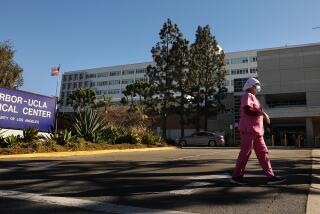Top-Tier Hospital May Be Worth the Trip
- Share via
Patients with severe injuries are 20% more likely to die of them if taken to a second-tier trauma center rather than the highest level, according to a study published this month.
The results, based on 248 trauma centers in a national database, suggest that for the worst traumas -- such as gunshot wounds to the chest -- it might be worthwhile to take patients to the best trauma center even if it isn’t the nearest, said Dr. Demetrios Demetriades, lead author of the study and head of the trauma unit at Los Angeles County-USC Medical Center.
The report by researchers at USC’s Keck School of Medicine reviewed outcomes of about 12,000 patients who entered trauma centers at high risk of imminent death or serious disability. It compared Level I centers, which meet the American College of Surgeons’ strictest standards, with Level II centers.
“Certainly if I am shot in the abdomen or the chest, I would want to be taken to a Level I trauma center,” Demetriades said.
The study could have major implications for paramedics, who now take trauma patients to the closest center, Demetriades said.
The American College of Surgeons defines Level I trauma hospitals as major regional academic centers that can perform surgeries 24 hours a day, that have a surgical intensive care unit and that provide ongoing research and training for surgical residents. Level II facilities are expected to provide high levels of trauma care too, but their standards are less stringent, they have fewer resources and they are not required to have teaching and research programs.
Among the survivors, researchers found, 34% of Level II patients were severely disabled at discharge, compared with 20% of Level I patients.
Los Angeles County has four Level I trauma centers -- at UCLA, UCLA-Harbor, Cedars Sinai and County-USC. There are nine Level II centers.
Some county health officials cautioned against applying the study’s results locally without further study.
The director of the county’s Emergency Medical Services Agency, Carol Meyer, said requirements for county Level II centers are significantly more stringent than those at the national level. The only difference between the two levels locally, Meyer said, is that a Level I center in Los Angeles County has research and surgical training programs.
“Our trauma surgeons and anesthesiologists have to be in the hospital 24 hours a day. In some Level II trauma centers [elsewhere in the nation], they don’t,” Meyer said.
Dr. Marc Eckstein, medical director of Los Angeles city Fire Department, said he recommended that a study look specifically at Los Angeles County.
“It stands to reason if you go to a facility that has the stringent requirements in terms of specialized staffing, you would expect patients who go there have better outcomes,” Eckstein said. “Like most good research, it merits further discussion.”
More to Read
Sign up for Essential California
The most important California stories and recommendations in your inbox every morning.
You may occasionally receive promotional content from the Los Angeles Times.














